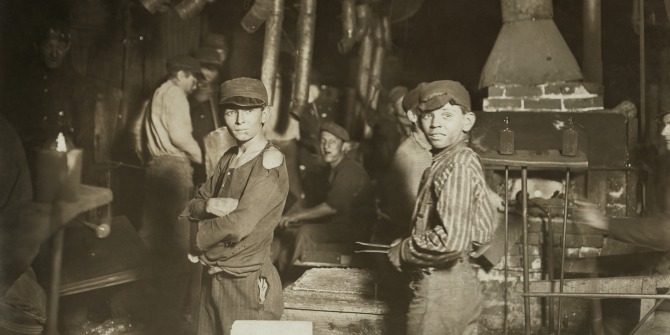 More than 40 years on, Jimmy Carter’s tenure as president is generally regarded as a mediocre one, especially considering the achievements of his successor, Ronald Reagan’s administration. David Wise suggests that we should re-evaluate Carter’s legacy, pointing out that many of Reagan’s policies, such as deregulation and intervening against the Soviets in Afghanistan had their roots in Carter’s presidency.
More than 40 years on, Jimmy Carter’s tenure as president is generally regarded as a mediocre one, especially considering the achievements of his successor, Ronald Reagan’s administration. David Wise suggests that we should re-evaluate Carter’s legacy, pointing out that many of Reagan’s policies, such as deregulation and intervening against the Soviets in Afghanistan had their roots in Carter’s presidency.
History has not been kind to engineers who became president. Just as Democrats for forty years ran against the memory of Herbert Hoover and the Depression, so too have Republicans for forty years made comparisons to Jimmy Carter, the 39th president who served from 1977 to 1981, when talking about supposed weakness or inflation.
It is even more unfortunate for Carter’s legacy that he was followed in office by comparisons with yet another president, Ronald Reagan, who was reputedly everything that Carter was supposedly not. And truth be told, Reagan is one of the most significant presidents in American history.
Reagan’s presidency began with Carter’s
Little appreciated or acknowledged, however, is how much Reagan’s presidency built off Carter policies.
Perhaps the single quote for which Reagan is best known was his remark “Mr. Gorbachev, tear down this wall.” It is often said that Reagan “won” the Cold War. But it was the supposedly soft Carter who deployed Pershing missiles to Germany and evaluated the deadly and controversial neutron bomb to counter Soviet threats to overrun Western Europe.
It was President Carter who led the United States to boycott the Moscow Olympics. It was the Carter administration that in 1979 began arming the Afghans who were pushing back on the Soviet invasion, a policy continued by President Reagan. Many historians believe that it was the Soviet withdrawal from Afghanistan that resulted in the collapse of what Mr. Reagan called “the evil empire.”
Re-evaluating Carter’s economic legacy
As a free market conservative Ronald Reagan was an advocate of minimal regulation. Perhaps his second most famous quotation was. “the nine most terrifying words in the English language are ‘I’m from the government and I’m here to help.’” Here again the Carter administration planted the seeds starting with the deregulation of the airline industry led by economist, political advisor, and Chair of the Civil Aeronautics Board, Alfred Kahn.

C136-4, President elect Ronald Reagan and President Jimmy Carter ride in a limousine to the U.S. Capitol for the Inaugural ceremony. Washington, DC. 01/20/1981. Courtesy Ronald Reagan Library.
The major plank of Reagan’s 1980 campaign was the proposal to effect large reductions in US income taxes. The theoretical foundation on which this policy was based was the so-called Laffer Curve, named after economist Walter Laffer, which held that lower taxes would increase tax revenues both by reducing tax avoidance and also increased productive effort (“supply side”) motivated by lower tax rates.
Here again, Carter had foreshadowed Reagan policies. One of the themes of Carter’s successful 1976 campaign resulted in the “Tax Reduction and Simplification Act of 1977” which lowered tax rates including a $900 billion reduction in corporate taxes.
On the other hand, there is no question that inflation was the black mark on the Carter presidency and the one thing for which those years are most often remembered. Carter’s first Fed appointment, G. William Miller, resisted strong members to fight inflation such that the inflation rate averaged 13.3 percent in 1979.
Forgotten in the footnotes is the fact that Paul Volker, the Federal Reserve chair who strangled inflation out of the economy – one of the biggest achievements of the Reagan administration – was appointed to that position by Jimmy Carter with the express mandate to tackle inflation.
Obscured by the record on inflation is the fact that the unemployment rate during Carter’s four years averaged better than the last four years of Nixon/Ford and Reagan’s first term. Manufacturing employment under Carter was the highest from 1940 to today.
Carter’s average GDP growth rate was 2.7 percent compared with Reagan’s 3.1 percent in his first term. Carter left the deficit and national debt as a percentage of GDP lower than he found them.
Beyond Carter’s “malaise”
Then, finally, is the word “malaise” which is commonly used to describe the Carter years. This word came about in response to the “Crisis in Confidence” speech in which the word “malaise” does not actually appear. That national address had two parts. First, a set of proposals to address the energy crisis plaguing the county at that time. The second was a statement about the decline in confidence in major institutions and a national sense of purpose and resolve. The first of these describes a policy program dramatically different than Reagan’s and has not aged well. The second, on societal fragmentation, was prescient.
It is on this latter point where there is little difference between the two men. In that speech Carter called for the nation to “rekindle our sense of unity, our confidence in the future.” In Reagan’s first inaugural address he said, “let us a renew our determination, our courage and strength. And let us renew our faith and hope.”
Reagan’s administration did not depend on Carter’s, but rather built on some of his predecessor’s actions and policy themes. Reagan’s significance and historical estimation surpasses Carter’s. Jimmy Carter suffered from being what voters always say they want, “a Washington outsider.” Carter came to Washington with few friends in Congress, the media, or the establishment. And he did not possess Reagan’s affability and communication skills. In the intervening years, many commentators have focused on these attributes rather than Carter’s actual policies and achievements.
- Please read our comments policy before commenting.
- Note: This article gives the views of the author, and not the position of USAPP – American Politics and Policy, nor the London School of Economics.
- Shortened URL for this post: https://bit.ly/41A1S6d






